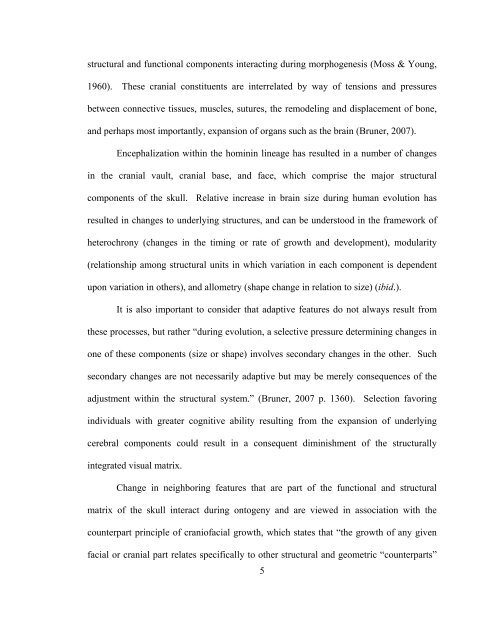modern variation and evolutionary change in the hominin eye orbit
modern variation and evolutionary change in the hominin eye orbit
modern variation and evolutionary change in the hominin eye orbit
You also want an ePaper? Increase the reach of your titles
YUMPU automatically turns print PDFs into web optimized ePapers that Google loves.
structural <strong>and</strong> functional components <strong>in</strong>teract<strong>in</strong>g dur<strong>in</strong>g morphogenesis (Moss & Young,1960). These cranial constituents are <strong>in</strong>terrelated by way of tensions <strong>and</strong> pressuresbetween connective tissues, muscles, sutures, <strong>the</strong> remodel<strong>in</strong>g <strong>and</strong> displacement of bone,<strong>and</strong> perhaps most importantly, expansion of organs such as <strong>the</strong> bra<strong>in</strong> (Bruner, 2007).Encephalization with<strong>in</strong> <strong>the</strong> hom<strong>in</strong><strong>in</strong> l<strong>in</strong>eage has resulted <strong>in</strong> a number of <strong>change</strong>s<strong>in</strong> <strong>the</strong> cranial vault, cranial base, <strong>and</strong> face, which comprise <strong>the</strong> major structuralcomponents of <strong>the</strong> skull. Relative <strong>in</strong>crease <strong>in</strong> bra<strong>in</strong> size dur<strong>in</strong>g human evolution hasresulted <strong>in</strong> <strong>change</strong>s to underly<strong>in</strong>g structures, <strong>and</strong> can be understood <strong>in</strong> <strong>the</strong> framework ofheterochrony (<strong>change</strong>s <strong>in</strong> <strong>the</strong> tim<strong>in</strong>g or rate of growth <strong>and</strong> development), modularity(relationship among structural units <strong>in</strong> which <strong>variation</strong> <strong>in</strong> each component is dependentupon <strong>variation</strong> <strong>in</strong> o<strong>the</strong>rs), <strong>and</strong> allometry (shape <strong>change</strong> <strong>in</strong> relation to size) (ibid.).It is also important to consider that adaptive features do not always result from<strong>the</strong>se processes, but ra<strong>the</strong>r “dur<strong>in</strong>g evolution, a selective pressure determ<strong>in</strong><strong>in</strong>g <strong>change</strong>s <strong>in</strong>one of <strong>the</strong>se components (size or shape) <strong>in</strong>volves secondary <strong>change</strong>s <strong>in</strong> <strong>the</strong> o<strong>the</strong>r. Suchsecondary <strong>change</strong>s are not necessarily adaptive but may be merely consequences of <strong>the</strong>adjustment with<strong>in</strong> <strong>the</strong> structural system.” (Bruner, 2007 p. 1360). Selection favor<strong>in</strong>g<strong>in</strong>dividuals with greater cognitive ability result<strong>in</strong>g from <strong>the</strong> expansion of underly<strong>in</strong>gcerebral components could result <strong>in</strong> a consequent dim<strong>in</strong>ishment of <strong>the</strong> structurally<strong>in</strong>tegrated visual matrix.Change <strong>in</strong> neighbor<strong>in</strong>g features that are part of <strong>the</strong> functional <strong>and</strong> structuralmatrix of <strong>the</strong> skull <strong>in</strong>teract dur<strong>in</strong>g ontogeny <strong>and</strong> are viewed <strong>in</strong> association with <strong>the</strong>counterpart pr<strong>in</strong>ciple of craniofacial growth, which states that “<strong>the</strong> growth of any givenfacial or cranial part relates specifically to o<strong>the</strong>r structural <strong>and</strong> geometric “counterparts”5
















